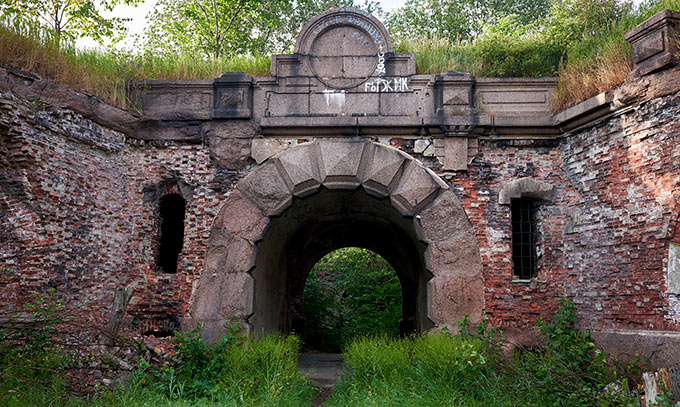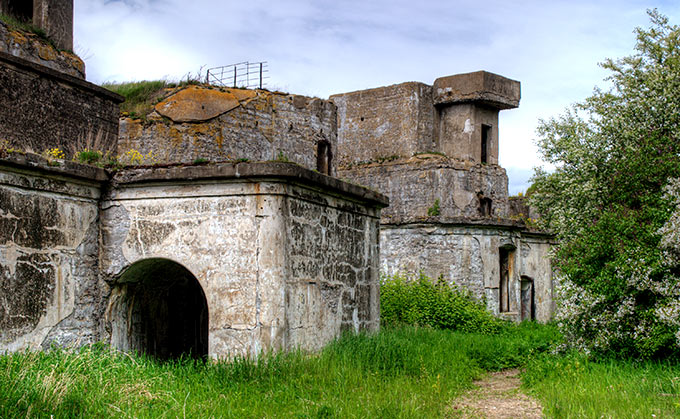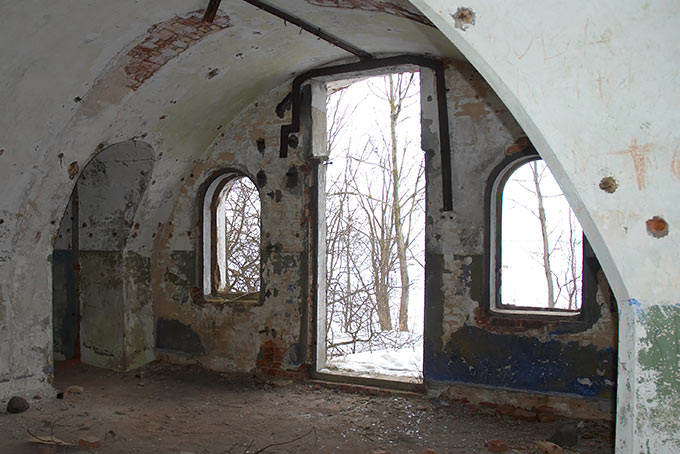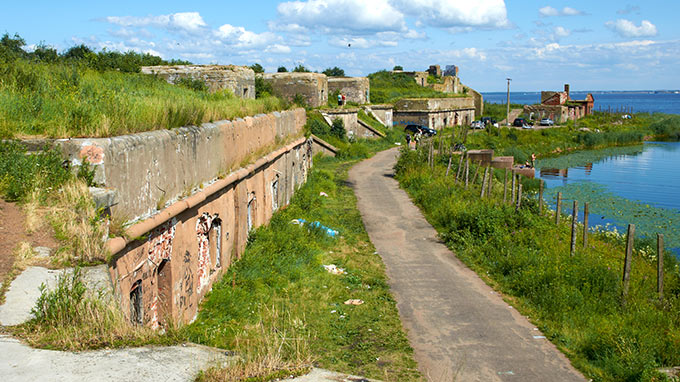Forts of the northern part of the Kronstadt fortress
Northern Forts is the circuit of 9 artillery forts (7 number forts and two new forts - Obruchev and Totleben). These forts are the sea artillery installations on the artificial islands which were built for protection of the northern fairway to St.Petersburg. Distances between them are near to 2-2,5 km for continuous gun's fire zone and convenient ammunition supply of forts by water.
The first fortification plane of the fairway was made in Peter Great times. However, the works began in 1800th. The continuous pile and rjazevy (the wooden frames filled with boulders and earth) barrier were arranged and two wooden artillery batteries on the piles were constructed also.
In 1824 forts were fairly destroyed by the strongest flooding. In 1827 was made decision to replace wooden strengthening by stone ones. Just before the Crimean War stone casemates were constructed. Its brick vaults had thickness in the lock near to 2 meters, all forts were reverted with a granite. Three other forts were built and now 5 casemat's forts defended Northern channel (##5-9 in old numeration).
In June 1854 the England-French sea squadron has approached near to Kronstadt. They sow to the forts and batteries, lost a pair of ships on mine obstacles (first-ever used here) and got out with anything. The same repeated in 1855-56.
In 1865-70 two extra forts were built with guns in open mountings behind of earth breastwork. In 1780 rearment on some forts was made and new 1877 9' and 11' guns were installed.
In 1884 guns were removed from casemates, and they were used as shelter and mine warehouses. In 1896 forts #3 and #5 outdated completely and were removed from the rank. On the Fort #1 in 1901-10 modernization works were conducted and it became key defensive position of Kronstadt together with newly constructed forts "Totleben" and "Obruchev" and battery "Konstantin".
In 1921 during the Kronstadt's mutiny against "Bolsheviks" garrisons of forts were on the insurrection's side.
1941 - WWII. German bomber's pilots has gloomy memoirs about anti-aircraft artillery of Kronstadt and its forts. They wrote that artillery and machine-guns were setting out in all possible places. Oservation posts, artillery positions and concrete machine-gun pillboxes are well-preserved on the forts from that times.
After WWII, forts were used as warehouses of naval property and ammunition. In 1960th, all guns and metal equipment were gathering for scrap metal - a vivid example of modern vandalism. A possible interesting tourist objects has been destroyed.
In 1970-90th of the last century, protective constructions of Leningrad from flooding (the Dam) were constructed. The dam has been laid straight through forts #3 and #7.
The present condition of forts is poor and pitiable. They are completely deserted, fairly dusted, collapsed, warned out by sand, its granite facing is stolen for gravestones, and Fort #3 will soon cease to exist because of excavations conducted on the dam.
Impressions
It was very curious to take a look. There are not so many such of installations in over the world, I mean, the combination of a rich history and present decline. In general, this ruins gives very strong impressions and associations for an inquisitive mind.
"If the sea fortress did not make any shot for all war and the enemy considered it unprofitable to enter with competition with it, this fortress will do its duty in the best way." - (Klado N.L. "About seaside fortresses from the point of view of fleet ". SPb., 1910). It is worth to agree with this statement, especially because the fortress with extreme expenses and deprivations was constructed after all.
Land forts and fortress:
Bip Castle Gatchina Ivangorod Izborsk Kexholm Kirillov Monastery Koporye Novgorod Pechorskiy Monastery Peter&Paul Fortress Porkhov Pskov Schlisselburg Staraya Ladoga Tikhvin Vyborg Hameenlinna Hamina Kastelholm Kymenlinna Lappaenranta Raseborg Castle Savonlinna Tavetti Turku Visby Fredrikstadt Fredriksten Hegra Fort Hoytorp Fort Arensburg Narva Tallinn Antipatris Caesarea Jerusalem Latrun Fort Masada
Sea forts and fortresses:
Alexander Fort Ino Fort Krasnaya Gorka Fort Kronstadt: Kotlin isl. Kronstadt: North Forts Kronstadt: South Forts Trongsund Hanko Svartholm Sveaborg Marstrand Siaro Fort Vaxholm Oscarsborg
Artillery batteries and individual guns:
Coastal Artillery Hemso Fort
Fortified areas and defensive lines:
Karelian Fortified Area (KaUR) KrUR Leningrad Mannerheim Line Nevsky Bridgehead VT Line Harparskog Line Salpa Line Gothland
Russian
S e a r c h All news






